Writing, this great achievement of mankind, had a long history of formation. This process has been going on for thousands of years.
With the advent of writing, people could no longer only communicate, but also store and transmit speech information using certain descriptive characters.
It is no longer possible to fully restore a consistent picture of the emergence and development of writing - the path was too long, and the origins of this path are hidden from us by time. But, nevertheless, historians trace individual stages of the path. For example, it is known that writing began with subject writing. What it is?
And, who knows, some of these writings will still give us emotions from the oldest vulgar testimonies, the bonus tickets of fifteenth-century Florentine women, or the letters of our emigrants and soldiers of the Great War. The author is a historian and journalist with a particular interest in interdisciplinary research.
But after you had the script, why did you need to create a Glagolitic script? One day at school, we learned that the Glagolitic script was created to translate sacred Christian books into it, since our previous script, as Chernorizes Grabar noted, was “features and cliffs,” that is, pagan. the signs of this script are also used in the Greek alphabet, one of the official alphabets of Christianity.
subject writing
Subject writing is symbolic objects (notches on a tree, stones arranged in a certain order, patterns on a smooth surface, smoke from a fire, etc.) that a person used to convey some necessary information. Of course, the person "reading" this information had to know the meaning of the items used, otherwise there was a danger of misreading.
How these signs came to the Greeks is another topic. These migrants brought their own letter with them, as it was used in today's Bulgarian lands - we know this from the tiles found near Karanovo, Grashnitsa and many other places in the country. When the Semitic peoples began to colonize Asia Minor from south to north, they inevitably came into contact with the alphabet they had found and adapted it to the needs of their language. About a thousand years later, in the 2nd millennium BC. one of these Semitic peoples, the Phoenicians, began to bring their ships further into the Mediterranean, and they had to protect their shelters from frequent storms - the most favorable were the deep bays of the Peloponnesian Peninsula in the southern part of the Balkan Peninsula.
Legend of Darius
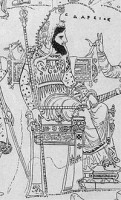
Image of Darius I on an ancient Greek vase. The work of the vase painter Darius
The ancient Persian king Darius, who went on a campaign to Scythia, received a message from the Scythians. It consisted of several items: frogs, birds, mice and 5 arrows. King Darius decided that the Scythians, as a sign of obedience, brought him earth, water and sky (a mouse means earth, a frog - water, a bird - sky, arrows - refusal to resist).  But one wise man did not agree with Darius. He deciphered the message of the Scythians in a different way: “If you, Persians, do not fly into the sky like birds, or, like mice, do not burrow into the ground, or, like frogs, do not jump into the swamp, then you will not come back, struck by these arrows” . This sage turned out to be right, Darius was forced to retreat, and this message will forever remain in history as a model of subject writing.
But one wise man did not agree with Darius. He deciphered the message of the Scythians in a different way: “If you, Persians, do not fly into the sky like birds, or, like mice, do not burrow into the ground, or, like frogs, do not jump into the swamp, then you will not come back, struck by these arrows” . This sage turned out to be right, Darius was forced to retreat, and this message will forever remain in history as a model of subject writing.
By the way, subject writing, with all the achievements of civilization, has survived in some places to this day: the peoples of Sumatra still use salt and pepper to denote love or hate.
The North American Indians had their own subject letter - wampum.
Gradually, these emigrants colonized the Peloponnese and began to move more and more north. Therefore, they came into contact with the local Thracians, called "pre-Greek population" by modern scholars. Their writing, due to their common root with the documented Phoenician script, was probably very similar to it, and the recently arrived colonists may have used it. Heraclids unanimously said that the word of Orpheus was written in several Thracian trays and they had priests to read them or were just Thracians.
But since this script, together with the language for which it was created, has evolved over the millennia here in the Balkans, why was it necessary to create a completely new writing system for this language, now under the name of Bulgarians? The key to the mystery may lie in the common root and graphic similarity between the ancient Thracian script developed in Cyrillic and the Greek alphabet used in the Byzantine Empire.

Wampum - Cylindrical shell beads strung on cords. These beads were multifunctional: they decorated clothes, served as currency, but their main purpose was to convey important messages. Wampums among the Iroquois tribes were usually delivered by special messengers - wampumons. For a long time, agreements between whites and Indians were formalized through wampums.
Subject writing, of course, was not the most convenient means of conveying information, so the search for more universal ways began. And it was found - this is a pictographic letter.
Let's see what is happening in Bulgaria and around it at the time of the creation of the Glagolitic. In 852, barely 20 years old, Khan Suybigi, Boris took the Bulgarian throne after the death of his father, a presbyter. The Russian version of the title "prince" means only "ruler", that is, it is not placed from heaven. another ruler, the Bulgarian rulers, apparently retain their title of khan of the suubiki until he is replaced by "king" Simeon the Great. It is very likely that Boris was one of the founders of his father in the last years of his life and was familiar with various options state development.
Pictographic letter

Eskimo pictographic story about a successful hunt
In pictographic writing, signs (pictograms) already designate a specific object. Pictograms were used by many cultures: Mesopotamian, Egyptian, Chinese, Aztec, etc. Pictographic writing is semantic, it denotes the simplest international concepts, real objects, phenomena, actions, the meaning of these actions conveyed through drawings. Pictographic writing could be understood by people who spoke different languages. Of course, pictographic writing could not form text, because it did not have developed rules of the language.
Pictograms are in demand in modern world: a graphical user interface for a computer, a red cross (hospital or first-aid post), a parking lot (letter P) and other signs, including road signs. In pictographic writing, the written sign is tied to a specific object.
Boris met Konstantin the Philosopher at the Bregalnitsa River. Bozhidar Dimitrov Kirill and Methodius are the grandsons of a very high Bulgarian boyar who fled from Bulgaria to Byzantium. Their family did not break their ties with the Bulgarian royal court, and this may be the reason for living in Thessaloniki, far beyond the capital of Constantinople - the Byzantines may have been afraid to spy on them for Bulgaria.
What they were talking about is not known, but according to the annals of that time, this certainly applies to Christianity. The baptism of the population of Bulgaria north of the Danube was probably also discussed. Many of the Bulgarian families of Bolyar, including the ruler, were also Christians, judging by the fact that about a hundred years ago, Khan Tervel was canonized as a Christian saint. But the conversion of the inhabitants north and northeast of the Danube by Bulgarian priests means the expansion of Bulgarian linguistic, cultural, political and economic influence in this region, that is, a new stage in the Byzantine struggle.
Hieroglyphic writing
The hieroglyph could already mean individual sounds and syllables, morphemes, whole words and concepts (ideograms). A feature of Chinese characters is the use of compound characters representing a combination of ideograms. An ideographic written sign is tied to a specific meaning.
But hieroglyphic writing had a significant drawback: it had no connection with the pronunciation of the word. As a result, written and oral speech existed separately, and in languages that are characterized by a change in the form of a word depending on its syntactic role, hieroglyphs had to be supplemented with special designations for word forms.
The water picks up the sound and you have to be near the speaker to hear it. Shortly after this meeting, Constantine settled in the monastery of St. Polychron on the Asian coast of the Bosporus, in the region of Bithynia in Byzantium, renouncing the prestigious post of head of the Patriarchal Library in Constantinople.
The chronicles do not answer the question why Constantine made this decision. Last year, his brother Methodius was in his monastery. Before settling, Metodi is governor of a large area north of Thessaloniki, which also includes the Bregalnica valley. And again we look at the chronicles, but they do not answer the question why he suddenly gives up his promising career and whether he participates in the meeting between Boris and Konstantin the Philosopher.
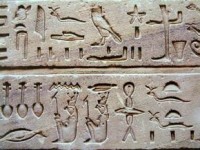
Egyptian hieroglyphic writing
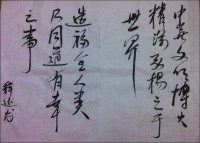
Chinese character writing
By 855 the new script is ready. It was developed mainly on the basis of the aphorial alphabet of the Ethiopian syllable. Contains symbols for consonants only, and each letter has so many spellings that the vowels can form a syllable with the corresponding consonant. Some of these variants are very similar to some Glagolitic letters. Abuja originated at the beginning of the last millennium for the Amharra language. Constantine the Philosopher probably knew Abuydad and used him, but he placed him in the Glagolitic signs and the main symbols of Christianity - the circle, the triangle and the cross.
syllabary
This letter is also called syllabic (from the French syllabe - syllable). The signs of this letter designate individual syllables. Typically, a character in a syllabary is a consonant followed by a vowel.
On average, syllabaries (syllabaries) have 80-120 characters.
Syllabic writing was a step towards the convergence of oral and written speech, as well as the formation of syllabic writing. The most famous syllabic scripts are cuneiform (ancient Persian, Akkadian and other heirs of the Sumerian script), West Semitic (Phoenician, Arabic and other heirs of ancient Egyptian hieroglyphics) and Japanese syllabic systems. The Phoenician letter played the most important role in the life of mankind: it was it that formed the basis of the Greek letter, from which the Latin, Cyrillic and most modern scripts originated. In a syllabary, each sign stands for a specific syllable.
He also put all his soul and his firm faith. Thus, the new Bulgarian alphabet did not publish whose supremacy it intends to accept Khan Suybigi Boris - Rome or Constantinople, and at the same time there was enough Christian to be recognized by both the patriarch and the pope.
Indeed, as subsequent developments show, his intention was not to accept supremacy. How recognition is achieved, we know well: in 862, when the alphabet had already been created and the most important liturgical books translated into Bulgarian, caused by the invasion of King Ludwig Herman, the Moravian Prince Rostislav sent envoys to ask the Byzantine Emperor for help and Christian priests to preach in a written language understandable to its people. Saints Cyril and Methodius were sent with their disciples, because they had knowledge of the Bulgarian language for the Rostislav people and were already famous Christian preachers.
Alphabetical letter
The Greeks, having started using the Phoenician script, faced the problem of fully conveying the sound of words. The Phoenician syllabic system lacked letters to represent vowel sounds. For the Greeks, this proved inconvenient. Therefore, special characters appeared to denote vowels. Thus, the letter moved to an even more universal level. Now, with the help of 30 signs that anyone could easily learn, it was possible to convey almost any word of oral speech.
Alphabetical letter turned out to be simple, so it quickly spread around the world. After all, it is not in vain that they say that everything ingenious is simple. But you have to grow up to genius. Although in some civilizations the transition to alphabetical writing did not occur.
Alphabets are called phonetic scripts that have a standard alphabetical order of characters. The characters of the alphabets are called letters.
A year later, however, Byzantium realized that instead of imposing influence on itself, it gained influence over Bulgaria and declared war on it. One of the terms of the peace treaty is to invite Byzantine priests to their churches. In the peace treaty after the war with the German kingdom ten years earlier, the condition is that Bulgaria invite Roman priests.
This cannot be a coincidence. Obviously, the diplomatic battle between Rome and Constantinople is affecting the spiritual life of Bulgaria in full swing. However, Bulgarian diplomacy also works tirelessly. Sending Cyril and Methodius to Great Moravia at that moment was unlikely without her help. And the Glagolitic alphabet, which resembles neither the Greek nor the Latin alphabet, played a decisive role in this epoch-making victory. In a word, it is quite possible that the Glagolitic alphabet was created with a political goal - Bulgaria, in order to make the most of the struggle between Rome and Constantinople and expand its influence to the north and northeast, including beyond its borders.
The path to the Russian alphabet
This journey was also long.
Greek alphabet
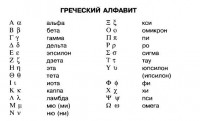
So the Greek alphabet was invented. It has been in continuous use since the end of the 9th or beginning of the 8th century. BC e. The Greek alphabet is considered the first alphabet to contain consonants and vowels and use separate characters for them. There are 24 letters in the alphabet (in the preclassical era, several more letters were used in some dialects of Greek).
It is no coincidence that less than 100 years after the creation of the Glagolitic alphabet, Bulgaria leaves it and returns to its famous ancient script, but is named after the Cyrillic alphabet - a bow to the great diplomat and philosopher. However, thanks to the Glagolitic, to this day it is the only language in Europe for which two different scriptures have been created.
Cyrillic is just the Greek alphabet, from which 5 letters were not made and 9 were added. Of the 24 letters we took. This alphabet did not make it Cyril, as you rightly noted. The Greek, in turn, is to the same extent a copy of the Phoenician. Therefore, we can say that ours is somehow Phoenicians. Cyril and Methodius are not Bulgarians, but Romans and high-ranking. And the alphabet created by Cyril was created by order of the Byzantine Emperor to connect the Slavs with the Christian family. In fact, with the act of baptism and acceptance Greek alphabet, the most important parts of the Bulgarian nationality - religion and writing - are wrong.
Etruscan alphabet
Based on the Western Greek alphabet, the Etruscan alphabet was created - a set of characters characteristic of the written Etruscan language. The Etruscan alphabet belongs to the Italic alphabets.
The most famous monuments of Etruscan writing are tombstones and ceramics. There are about 9 thousand known inscriptions made using the Etruscan alphabet - on tombstones, vases, statues, mirrors and jewelry. Fragments of the Etruscan linen book Liber Linteus were also found.
Etruscan writing is directed mainly from right to left, occasionally from left to right and boustrophedon: one line is written from left to right, the second line from right to left, the third from left to right, etc. The words were not always separated from each other.
In fact, Khan Kubrat is not right that the Greeks serve only the Greek alphabet, we and all Cyrillic. All other letters were in the Chalcedonian alphabet, from which the Romans copied. And these facts should only be a turmoil in the strong nationalist convictions of some compatriots. However, since we get rid of them, we can return to the alphabet again.
Now you need to convince all of Western Europe and Americans that they actually write in the Greek alphabet. The Cyrillic alphabet was not created by Cyril and Methodius, for whose nationality there was a dispute, but by a pure Bulgarian - Clement of Ohrid and named the Cyrillic alphabet in honor of his teacher Cyril. In the first six letters in Bulgarian, the following sentence is encoded, since the letters in the alphabet were pronounced at that time.
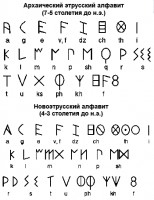
Reconstruction of Etruscan alphabets
The Etruscan inscriptions were already incomprehensible to the Romans, who had a proverb “etruscum non legitur” (“Etruscan is not readable”). All later attempts to read the Etruscan inscriptions on the basis of any of the known languages were unsuccessful. It is believed that the Etruscan language is not related to known European languages and is isolated.
Inspired by this coding, Konstantin Preslavsky wrote On Letters. Cyril and Methodius actually created an alphabet called the Glagolitic. Interestingly, two high-ranking Romans, that is, Greeks, went to Rome to ask that the Slavic peoples have the right to glorify God in their mother tongue and not in Greek or Latin.
It is this act of the two brothers that for me is the most convincing of their, if not the origin of the blood, and then the spiritual affiliation. And this, of course, is Bulgarian, since at the time in question Bulgaria is the only great Slavic state. At that time, the days of Cyril and Methodius did not exist at the national level. With us, abstraction comes a little later, again in the Greek model, Paisios thinks about it. And the Greeks think about this Western people, fascinated by their ancient statues, which the Greek Greeks then did not have, and they do not pay attention to them.
Latin alphabet
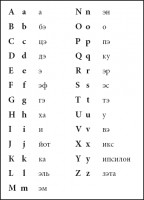
The Latin alphabet also goes back to the Greek alphabet. Letter writing, which arose in Latin in the middle of the 1st millennium BC. e., subsequently spread throughout the world. The modern Latin alphabet is the basis for writing most Romance, Germanic and many other languages. Basic option Latin alphabet consists of 26 letters. Letters are called differently in different languages.
Writing based on the Latin alphabet is used mainly by all languages of the Romance group, except for a few languages; Germanic group (except for Yiddish); Celtic and Baltic groups, as well as some languages of the Slavic, Finno-Ugric, Turkic, Semitic and Iranian groups; Albanian, Basque languages; some languages of Indochina (Vietnamese), Myanmar, most of the languages of the Sunda Archipelago and the Philippines; Africa (South of the Sahara), America, Australia and Oceania, as well as artificial languages (for example, Esperanto).
Coptic script
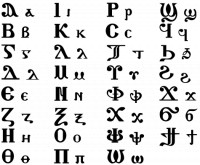
Coptic alphabet
The Coptic alphabet has been common since the 4th century BC. It is based on the Greek alphabet, with the addition of a few letters from the ancient Egyptian Demotic script to represent consonants not found in Greek.
Coptic writing was one of the sources of Old Nubian writing.
Gothic letter
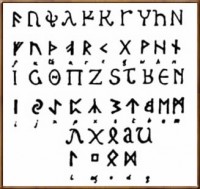
Gothic alphabet
The Gothic alphabet was created on the basis of Greek with borrowings from Latin. The names of the letters come from the names of the runes. The creation of the alphabet is attributed to Bishop Wulfila (Ulfila), who created in the middle of the 4th century. translation of the Bible into Gothic. Prior to this, the Goths used runic writing (the writing of the ancient Germans). The Goths are an ancient Germanic union of tribes.
Cyrillic
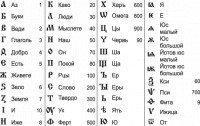
Cyrillic - Old Slavonic alphabet (Old Bulgarian alphabet); alphabet: one of two (along with Glagolitic) ancient alphabets for the Old Church Slavonic language. The modern Russian language goes back to the Cyrillic alphabet.
Cyrillic-based alphabets are or were the writing system for 108 natural languages, including the following Slavic languages:
Belarusian language (Belarusian alphabet)
Bulgarian language (Bulgarian alphabet)
Macedonian language (Macedonian alphabet)
Rusyn language/dialect (Rusyn alphabet)
Russian language (Russian alphabet)
Serbian language (Serbian Cyrillic alphabet)
Ukrainian language (Ukrainian alphabet)
Montenegrin language (Montenegrin alphabet).
In Soviet times, the alphabets of almost all non-Slavic peoples of the USSR (with the exception of Estonians, Latvians, Lithuanians, Georgians and Armenians) and Mongols were built on the basis of the Cyrillic alphabet. By the time of the collapse of the Soviet Union, peoples speaking more than 60 languages and making up about 10% of the world's population used the Cyrillic script.
An alphabet is a specific form of writing based on a standardized set of characters. They denote linguistic phonemes, but there is practically no unambiguous correspondence between sounds and letters. It is believed that the first alphabet was invented in the Phoenician state about 3 millennia ago. However, some historians believe that such writing systems existed earlier, but the Phoenician letter is the progenitor of modern alphabetic systems.
In the XIX-VIII century BC. The Phoenician alphabet was borrowed by the Greeks, who for a long time used it almost unchanged. As a result, the names of the Greek letters practically do not differ from those used in the Phoenician alphabetic system.
But on the basis of the Greek alphabet, the Latin alphabet appeared, which soon became the main writing system for almost all the peoples that inhabited the European continent. Somewhat later, on the basis of the Latin alphabet, the Cyrillic alphabet was created, which is used by us to this day. Although individual facts indicate that even without the invention of Cyril and Methodius, the Slavic peoples had their own writing system - Glagolitic, and even earlier - runic writing.
At the beginning of the 5th century AD. Monk Mesrop Mashtots created the Armenian alphabet, which had 22 characters, which is very reminiscent of the Phoenician system already familiar to us. The latter, having undergone significant changes over time, became the basis for the development of the written language of the Semitic languages.
It should be noted that the letters, for example, of the Hebrew alphabet, are written somewhat differently than in the Phoenician system, but their names and sequence have remained almost the same.
Linear alphabetic systems became widespread in the 14th century - it was then that the proto-Canaean and proto-Sinaitic varieties of writing arose. In these alphabets, there is a connection between pictography and phonetics, as in the Old Slavic Glagolitic alphabet. Ugaritic texts dating back to the 13th century deserve special attention. They contain 30 cuneiform symbols, which defines the Ugarit alphabet as the first non-acrophonic system.
One way or another, it is impossible to do without the alphabet today. Without knowing the shape of the letters, their phonetic sound and meaning, it is impossible to read a single inscription, whether it is an advertising sign or the title of a book. The modern alphabet is a universal system by which speech can be recorded and accurately reproduced by anyone who knows the language.
Among all the types of writing that have ever existed, only the alphabet and hierography have passed the test of time. As for the latter, it is widely used in many eastern countries. But it is the alphabet that is the basis of the writing system of most developed countries of the world.
Alphabetical writing is a standardized set of characters - letters - each of which stands for one or more phonemes. The signs of the alphabet are divided into vowels and consonants, and in each language this division has its own characteristics. Letters are used to form words.
Origin of alphabetic writing
Modern Western alphabets are direct descendants of the Latin alphabet used by the Romans. It should be noted that this alphabetic system has several drawbacks with respect to a single language. For example, the English alphabet contains several specific letters representing several phonemes, while lacking the signs necessary to convey specific consonants. As for the Cyrillic alphabet, it has undergone significant changes since the time of Cyril and Methodius. The Cyrillic alphabets used in different states differ significantly from each other, just like the languages spoken by the local population.
Alphabetical writing reflects the phonetics of the language, therefore it has significant advantages over non-alphabetic systems. However, it is precisely this property of the alphabet that is at the same time its disadvantage, because living speech changes very intensively over time. This leads to the fact that the alphabetic system gradually loses its effectiveness, since it conveys the phonetic features of the language less and less accurately. At the same time, with the change in phonetics, the alphabet itself is modified, albeit very slowly, and, as a result, new words and concepts appear.
But be that as it may, alphabetic systems are much easier to learn. A person who understands the structure of the native alphabet can, with certain knowledge, quite successfully read foreign texts. However, the skill of the translator alone is not enough here. After all, it is extremely necessary to understand the way of thinking that is transmitted in writing. And this, in turn, is possible only with a deep study of the character colloquial speech one country or another.



